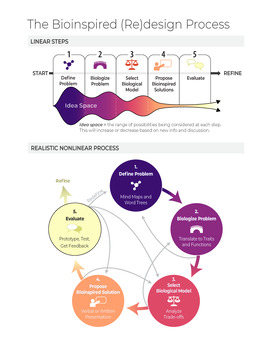Bioinspired Design: Looking to Biology for Better Solutions
9 Downloads
Galactic Polymath
3 Followers
Grade Levels
8th - 12th, Higher Education, Homeschool
Subjects
Resource Type
Standards
NGSSHS-LS2-7
NGSSMS-LS2-5
NGSSMS-LS3-2
NGSSHS-LS4-4
NGSSMS-LS4-4
Formats Included
- PDF
Galactic Polymath
3 Followers
Description
Are you looking for a design thinking challenge that bridges biology and engineering? Are you tired of design challenges that lack scientific rigor?
Look no further! In this design challenge, students will identify a problem with an existing product and investigate biological functions to inspire a product redesign. Through independent research using AI bots and scholarly sources, students will gain a new perspective on STEM, biology, and the human interface between.
Total Pages
Answer Key
N/A
Teaching Duration
1 Week
Report this resource to TPT
Reported resources will be reviewed by our team. Report this resource to let us know if this resource violates TPT’s content guidelines.
Standards
to see state-specific standards (only available in the US).
NGSSHS-LS2-7
Design, evaluate, and refine a solution for reducing the impacts of human activities on the environment and biodiversity. Examples of human activities can include urbanization, building dams, and dissemination of invasive species.
NGSSMS-LS2-5
Evaluate competing design solutions for maintaining biodiversity and ecosystem services. Examples of ecosystem services could include water purification, nutrient recycling, and prevention of soil erosion. Examples of design solution constraints could include scientific, economic, and social considerations.
NGSSMS-LS3-2
Develop and use a model to describe why asexual reproduction results in offspring with identical genetic information and sexual reproduction results in offspring with genetic variation. Emphasis is on using models such as Punnett squares, diagrams, and simulations to describe the cause and effect relationship of gene transmission from parent(s) to offspring and resulting genetic variation.
NGSSHS-LS4-4
Construct an explanation based on evidence for how natural selection leads to adaptation of populations. Emphasis is on using data to provide evidence for how specific biotic and abiotic differences in ecosystems (such as ranges of seasonal temperature, long-term climate change, acidity, light, geographic barriers, or evolution of other organisms) contribute to a change in gene frequency over time, leading to adaptation of populations.
NGSSMS-LS4-4
Construct an explanation based on evidence that describes how genetic variations of traits in a population increase some individuals’ probability of surviving and reproducing in a specific environment. Emphasis is on using simple probability statements and proportional reasoning to construct explanations.





